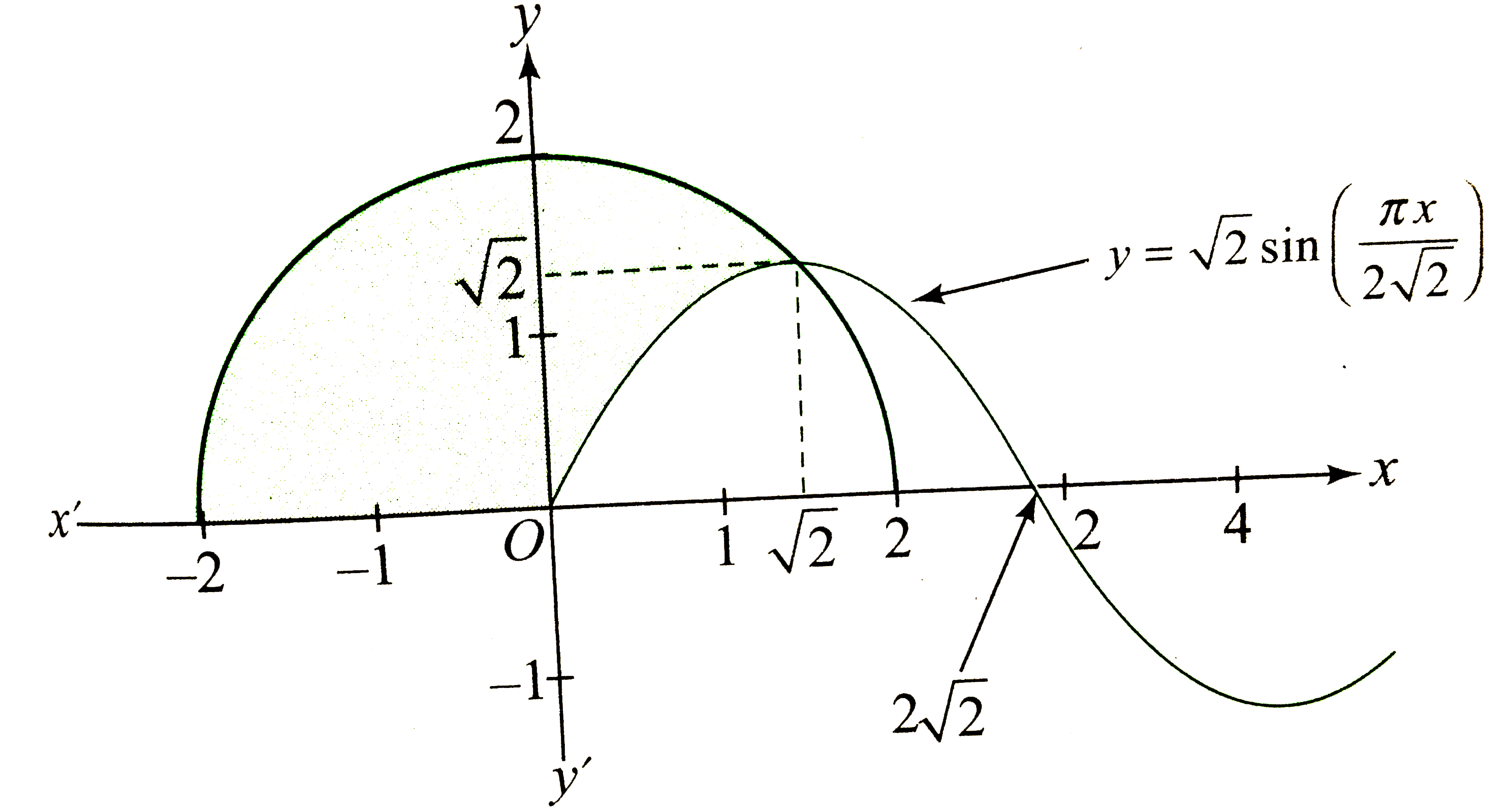The area enclosed by the curve y=√4−x2,y≥√2sin(xπ2√2)
, and the x-axis
is divided by the y-axis
in the ratio.
(a) π2−8π2+8
(b) π2−4π2+4
(c)π−4π−4
(d) 2π22π+π2−8Solution in Bengali
π2−8π2+8
π2−4π2+4
π−4π−4
2π22π+π2−8
The correct Answer is:D
y=√4−x2,y=√2sin(xπ2√2) intersect at x=√2

Area of the left of y-axis is π
Area to the right of y-axis
=√2∫0(√4−x2−√2sinxπ2√2)dx
=(x√4−x22+42sin−1x2)√20+(4πcosxπ2√2)√20
=(1+2×π4)+4π(0−1)
=1+π2−4π
=2π−π2−82π sq. units
∴ Ratio=2π22π+π2−8.
Topper's Solved these Questions
- BOOK - CENGAGE PUBLICATIONCHAPTER - AREAEXERCISE - Multiple Correct Answers Type13videos
AREA
- BOOK - CENGAGE PUBLICATIONCHAPTER - AREAEXERCISE - Linkded Comprehension Type21videos
AREA
- BOOK - CENGAGE PUBLICATIONCHAPTER - AREAEXERCISE - Concept Application Exercise 9.37videos
AREA
- BOOK - CENGAGE PUBLICATIONCHAPTER - APPLICATIONS OF DERIVATIVESEXERCISE - Subjective Type2videos
APPLICATIONS OF DERIVATIVES
- BOOK - CENGAGE PUBLICATIONCHAPTER - BINOMIAL THEOREMEXERCISE - Comprehension11videos
BINOMIAL THEOREM
Similar Questions
Let A(k) be the area bounded by the curves y=x2−3 and y=kx+2 The range of A(k) is (10√53,∞) The range of A(k) is (20√53,∞) If function k→A(k) is defined for k∈[−2,∞ ), then A(k) is many-one function. The value of k for which area is minimum is 1.
05:40View SolutionLet Ar be the area of the region bounded between the curves y2=(e−kr)x(where k>0,r∈N) and the line y=mx(where m≠0), k and m are some constants
A1,A2,A3,… are in G.P. with common ratio03:20View SolutionFind the continuous function f where (x4−4x2)≤f(x)≤(2x2−x3) such that the area bounded by y=f(x),y=x4−4x2. then y-axis, and the line x=t, where (0≤t≤2) is k times the area bounded by y=f(x),y=2x2−x3,y-axis , and line x=t(where0≤t≤2).
05:42View SolutionProve that for λ>1, the equation xlogx+x=λ has least one solution in [1,λ].
09:10View SolutionConsider a G.P. with first term (1+x)n, |x|<1, common ratio 1+x2 and number of terms (n+1). Let 'S' be sum of all the terms of the G.P., then
The coefficient of xn is 'S' is05:27View SolutionSmaller area enclosed by the circle x2+y2=4and the line x+y=2is
(A) 2(π−2) (B) π−2 (C) 2π−1 (D) 2(π+2)03:55View SolutionIf (sinx)(cosy)=12, then d2ydx2 at (π4,π4) is (a) −4 (b) −2 (c) −6 (d) 0
03:17View SolutionLet f(x) be a non-negative continuous function such that the area bounded by the curve y=f(x), the x-axis, and the ordinates x=π4andx=β>π4isβsinβ+π4cosβ+√2β. Then f′(π2) is (π2−√2−1) (b) (π4+√2−1) −π2 (d) (1−π4−√2)
13:30View SolutionThe area enclosed by the curve y=√4−x2,y≥√2sin(xπ2√2) , and the x-axis is divided by the y-axis in the ratio. (a) π2−8π2+8 (b) π2−4π2+4 (c)π−4π−4 (d) 2π22π+π2−8
02:04View SolutionArea enclosed by the curve (y-sin^(-1)x)^(2)=x-x^(2), is (A) (pi)/(2) sq.units (B) (pi)/(4) sq.units (C) (pi)/(8) sq.units (D) none of these
13:45View SolutionThe possible values of theta in (0, pi) such that sin (theta) + sin (4 theta) + sin (7 theta) = 0 are (1) (2 pi) / (9), (i) / (4 ), (4 pi) / (9), (pi) / (2), (3 pi) / (4), (8 pi) / (9) (2) (pi) / (4), (5 pi ) / (12), (pi) / (2), (2 pi) / (3), (3 pi) / (4), (8 pi) / (9) (3) (2 pi) / (9 pi) ), (pi) / (4), (pi) / (2), (2 pi) / (3), (3 pi) / (4), (35 pi) / (36) (4) (2 pi ) / (9), (pi) / (4), (pi) / (2), (2 pi) / (3), (3 pi) / (4), (8 pi) / (9)
10:10View Solutionint[sin^(2)((9 pi)/(8)+(x)/(4))-sin^(2)((7 pi)/(8)+(x)/(4))]dx
04:41View SolutionIf the parabola y=(x^(2))/(2) divides the circle x^(2)+y^(2)=8 into two parts,then the area of the parts may be (A) 6 pi+(4)/(3) sq.units (B) 2 pi-(4)/(3) sq.units (C) pi+(4)/(3) sq.units (D) 6 pi-(4)/(3) sq.units
01:31View Solution∫π2/40sin√x√xdx equals
a. π2/8
b. π/4
c. 2
d. 110:11View SolutionLet y=y(x) be the solution of the differential equation, dydx+ytanx=2x+x2tanx,x∈(−π2,π2), such that y(0)= 1. Then (a) y'(π4)−y'(−π4)=π−√2 (b) y'(π4)+y'(−π4)=−√2 (c) y(π4)+y(−π4)=−π22+2. (d) y(π4)−y(−π4)=√2
03:40View SolutionThe area enclosed by the curve y=√4−x2,y≥√2sin(xπ2√2) , and the x-axis is divided by the y-axis in the ratio.
(a) π2−8π2+8
(b) π2−4π2+4
(c)π−4π−4
(d) 2π22π+π2−803:07View Solution

